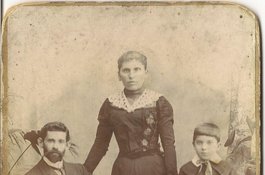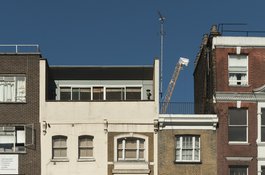92-3 Whitechapel High Street
Contributed by Survey of London on July 12, 2018
This pair of narrow shop-houses has been a single building since 2002, the
shop portion since 1990 at the latest. Both were built in 1861-2, No. 92 to
the designs of G. H. Simmonds, architect of the Eastern Dispensary in Leman
Street (and displays a
similar taste for rusticated quoins) and alterations to St Mary Street
school. The client was the Whitechapel Charities, which was an assortment
of parish-run charities, which had owned the house since, at latest, the
1750s. It was leased from 1748 to 1804 to the hosier and worsted
manufacturer George Shelley, and later his son.
From 1863 No 92 was the home of John Stephens (1808-80), a greengrocer-turned-
medical botanist, who had been acquitted in 1851 for manslaughter after
administering a powder containing cayenne pepper and lobelia. At No. 92 he
pursued his alternative practice, hosted sessions led by his mentor, the
American Dr Albert Isaiah Coffin, and established the Anti-Compulsory
Vaccination Society in 1869: ‘let us throw off this tyranny’.
The building previously and subsequently in the nineteenth century was more
conventionally occupied by a succession of milliners, silversmiths, jewellers
and feather dealers followed by corset-makers, and dealers in gowns and
knitted goods. Even so, it had links with eminence of different kinds.
Reginald (Peter) Southouse Cheyney (1896–1951), who rose to success as an
author of crime fiction, was born here, and Abram Bronowski, father of the
mathematician and broadcaster Jacob Bronowski, was here in the 1930s, as was
Gelkoff's, confectioners, from 1956 to 1988. Along with No 93, the shop is
now a Costcutter supermarket.
No 93 is more stolidly commercial than its twin at 92, with simple pairs of
windows, the whole front now rendered. Its predecessor, with five hearths, was
from the 1660s to his death in 1683, the premises of Christopher Worth, a
tallowchandler, who issued trade tokens with the sign of the hen and
chickens. He left the house and business to his relative Robert Worth and
the rest to his daughter Hannah and son-in-law Mordecai Fromanteel, a
silkthrowster and part of the extended Fromanteel family that included his
uncle, the clockmaker Ahasuerus Fromanteel. The wholesale stationer
Nathaniel Mead was here from the 1820s to the 1840s, latterly with his partner
Nathaniel Powel, before their move to the larger No.
101 in 1848. The
building’s lengthy back extension, added in 1881-2, once hemmed in by the
buildings of Spread Eagle
Yard and Inkhorn
Court, is now marooned in
the NCP car park. No. 93 was a building of many businesses (hats, cigars,
dining rooms) in the later nineteenth century, few apart from Henry Coe, brush
manufacturer there for twenty years to the 1870s, staying more than a few
years. The twentieth century was, with the exception of Lewis, photographers,
here c. 1917, in typical Whitechapel rag trade use, with Max Prevezer, a
reticent wholesale hosier, in occupation from the 1930s to the 1980s.
In 2002 the upper floors of the two buildings were fully integrated in
conversion into self-contained flats, known as Atlantis House, and an extra
storey was added.
.jpg.265x175_q85_crop-0%2C0.jpg)

